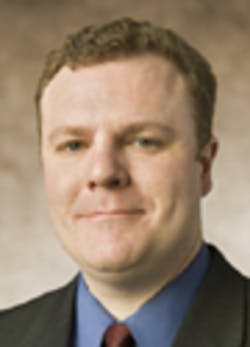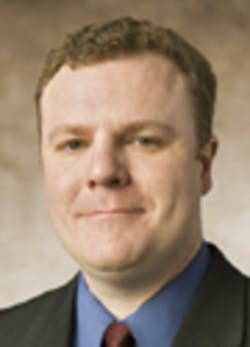Performance Oscilloscopes Tackle Serial-Bus, Computer Test
Tektronix has recently rolled out support for a variety of standards including 100G Ethernet, PCI Express, and MOST. And at DesignCon in January, Tektronix debuted its SDLA Visualizer and P7600 30-GHz Probing System.
Brian Reich
Brian Reich, general manager, Performance Oscilloscopes, said these initiatives have been in support of key drivers for the performance oscilloscope marketplace. He defined performance oscilloscopes as having real-time bandwidths in the 4-GHz and up range or sampling scopes operating at 20 GHz and above.
Drivers for the oscilloscope business, he said, include optical and electrical data communications as well as high-speed serial buses and memory interfaces. Reich’s division also makes high-end logic analyzers, which primarily address the computer world, and BERTs, which play in both the computer and communications worlds.
The SDLA and 30-GHz probing system, he said, serve serial bus applications at 6 GHz and above. The SDLA helps designers understand how to open a closed eye at the end of, for example, a 10-Gb/s link. “Semiconductor manufacturers are using pre-emphasis on the transmitter side and equalization on the receiver side to open that eye back up. The SDLA tool enables you to acquire your signal with an oscilloscope and then apply some of those same equalization and simulation techniques at multiple points to determine what the receiver is actually seeing.”
The 30-Gb/s probing station also targets serial standards at 10 Gb/s and above. “PCI Express Gen 4 is on the horizon—that’s a 16-gig interface. This probe is a nice way to acquire that signal.” He said the probe’s TriMode capability lets users, with one connection, make single-ended, differential, and common-mode measurements.
Whereas once customers choosing an oscilloscope focused on banner specs—bandwidth, sample rate, and record length—now they look for a comprehensive tool that can address standards-based applications. Reich said, “Our solutions build in the intelligence of the standard so the user can, in an automated fashion, perform compliance testing.” And should compliance testing fail, users can employ DPOJET, which Reich described as a “robust set of debug and analysis tools linked with our automation packages. If users go through their tests and get a failure, they can use the DPOJET toolset to find the root cause.”
Tektronix takes a twofold approach to standards. “We work closely with our customers to look for emerging trends and see what specific standards our customers will be incorporating into their designs,” Reich said. In addition, he noted, “We also are very active in a lot of the key standards bodies, like JEDEC and PCI SIG, for two reasons: first to see what is on the horizon so we can be ready when our customers need to start testing, and second to work with the standards bodies to help define optimal test methodologies.”
Reich’s division works with other Tektronix divisions to share key technology components. In addition, Reich said, “The applications solutions we develop in many cases are multi-instrument.” For example, he said, a peer organization makes the company’s source/analyzer product line, and “…our solutions sometimes incorporate an AWG as a source for receiver testing, so we configure the AWG to work with the oscilloscope in one automated package.” In addition, he said, his group’s oscilloscopes can run the spectrum-analyzer group’s user interface, enabling a scope to serve as a wideband acquisition device in some RF applications.
Reich said that, moving forward, customers will look for increased performance as well as the ability to handle increased complexity. He cited as an example the link-training function in PCI Express, in which transceivers try to establish, for example, Gen 3 speeds, falling back to Gen 2 and Gen 1 as necessary. With such functions, instrumentation must provide protocol-layer support simply to initiate physical-layer tests, he said.
The lines between traditional classes of instruments may be blurring. “That’s been a trend happening over a number of years, and I definitely see that continuing,” Reich said. “In our portfolio, we now have not only oscilloscopes, but also mixed-signal oscilloscopes with digital channels, and now mixed-domain instruments with RF, digital, and analog all in the same box. We’re extending the capability for our scopes to do protocol analysis. I think the oscilloscope is really the Swiss army knife of an engineer’s toolset, and it lends itself really well to taking on additional types of capabilities beyond just the traditional analog acquisition that it has in the past.”

